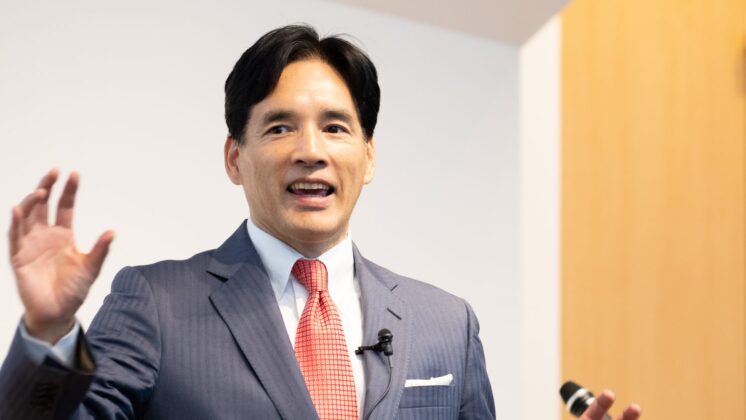We are thinking about creating full-time graduate university campus in the middle of the mountains.
Our urban campuses in Tokyo, Nagoya, and Osaka offer business administration courses in the evenings and on weekends, enabling students to attend while continuing to work. Many talented people are taking advantage of this, but the system makes it difficult to invite students from abroad and hold executive programs in a retreat-style setting.
A full-time campus out in the mountains would enable us to invite students and lecturers from overseasーand offer an MBA program in English. Of course, our intention is to have credits earned in this program and at our urban campuses be interchangeable. Both programs will have the same value.
Realizing this vision of a mountain campus will require long-term planning, but luckily, that’s nothing new for us.
I began GLOBIS when I was 30, 12 years ago. In eight years, when we reach our second decade, I want to have decided where the new campus will be. I want us to have started construction, and begin to invite students from abroad. In 18 years, by our third decade, our goal is to be the No. 1 business school in Asia.
In the context of this long-term vision, I spent the weekend looking at potential campus locations.
My first thought was to look at Karuizawa, which is easily accessible from Tokyo, steeped in culture, and would never become boring for students. It boasts the magnificent Mount Asama, and the surrounding area is beautiful in every season throughout the year.
The only problem is that I have heard it is difficult to gain permit approval. It’s also a bit far from any international airportsーnot great in terms of overall access, and not very convenient for our other campuses in Osaka, Nagoya, and Fukuoka. At first, I kind of liked the lifestyle appeal in Karuizawa, partly because it is near my mountain lodge, but we’ve got lots of time before we start construction, so I’m going to broaden my search for potential sites to the whole of Japan.
That’s why I am now in Fukushima Prefecture, in the town of Bandai in the Aizu area. Bandai is at the foot of Mt. Bandai, which is celebrated in a popular Japanese folk song called, “Aizu Bandai Mountain.” I’m here with my wife and four kids, as well as a few family friends. The reason I chose Bandai is because Mr. Hoshino, president of Hoshino Resorts, said to me, “Karuizawa isn’t bad, but Fukushima has an international airport, Mt. Bandai is stunning, and it is relatively easy to gain permit approval, so it would be very promising as a potential campus.”
Hoshino kindly gave a speech at the last GLOBIS Club session, a seminar for GLOBIS students. He has under his umbrella the Rizonare resort in Kobuchizawa, Yamanashi, and has also taken on the Alts Bandai Ski Resort in Aizu, Fukushima. He recently started working toward revitalizing the Alpha Resort Tomamu in Hokkaido.
Hoshino completely turned Rizonare around and increased the number of skiers in Alts Bandai, making it the number one ski resort in the Tohoku region. His revitalization strategies turned out to be really effective. He is one year older than I am, and our families, including the kids, have started hanging out together. He is the owner and president of a family corporation, and I am an entrepreneur. Our positions are different, but I really look up to him as an innovative leader in resort management.
His enthusiastic endorsement of Bandai was enough to make me want to pay a visit.
We took the Tohoku bullet train as far as Koriyama, then changed to the Aizu Liner on the JR Banetsu-sai line, arriving in Bandai just before nine in the evening.
I took a stroll the following morning. Hoshino showed me around. I was born in neighboring Ibaraki Prefecture and had an overall sense of Aizu’s geography, as I had been there on school and swimming club trips. Hoshino sold it well: “Famous places abound in this area: Inawashiro, Aizu Wakamatsu, Goshikinuma, Kitakata, which is known for its ramen, Mt. Iimoriーmade famous by Byakkotaiーand Mt. Bandai itself. But it is not being effectively developed as a tourist destination, so the area has not been able to attract many customers.”
The large-scale Alts Bandai resort was built in 1986 when the Resort Law was enacted, originally as a joint public-private venture by a consortium, including the town of Bandai, a real estate developer, a major airline, and a large trust bank. It covers some 9,930 square kilometers reaching halfway up Mt. Bandai. It has golf courses and ski slopes, as well as educational and training facilities and a natural hot spring. It is said that around 110 billion yen has already been invested in it.
Yet, because it has everything, the impression it gives is somewhat vague. This is why management is stuck and Hoshino Resort has been entrusted to turn things around.
Halfway through our stroll, we popped into a sake brewery of Eisen Shuzou. When Alts Bandai was built, the brewery moved here for the clean water. We sampled Ginjyo, Daiginjyo and umesake (plum wine). Each was delicious, particularly the umesake. I asked why it was not called, umeshu, the common term for liquor distilled from plum, and was told that umeshu is made from a Japanese liquor, called shochu, whereas umesake is made from Japanese sake. So the name was chosen to differentiate it from umeshu. Feeling cheerful, I bought a bottle, and we continued our stroll.
Hoshino Resort has been working on a strategy for participating in the management of Alts Bandai. The first part of their plan was to focus on pulling in winter skiers. Resources would not be deployed for summer activities until the concept was completely clear. It was a case of concentrating resources.
They were devoted to increasing repeat ski customers, as well as families. They particularly beefed up ski instruction toward helping people to fully experience the sense that they were improving their skiing, which would make them want to come back again and again.
They even introduced a satisfaction guarantee on their curry rice. I had previously spoken to Hoshino about the GLOBIS quality guaranteeーif students have any reservations about the quality of instruction after having completed the entire course, we unconditionally refund all course fees. This is a powerful customer satisfaction system.
Following this example, Hoshino introduced the curry rice satisfaction guarantee in Bandai Alts. Apparently, it worked very well as a publicity device.
The general manager in charge of implementing these initiatives is a graduate of GLOBIS. I know him myself, and he welcomed me at the entrance hall when I arrived at Bandai Alts. Amidst an overall downturn in the number of skiers going to the Tohoku region the previous year, Bandai Alts had been the only resort to show a two percent increase due to the measures implemented by the general manager. Not only thatーit was the first upturn in the last ten years.
Now a concept committee was working day and night to come up with a plan to increase customer numbers during the summer. Hoshino explained, “The key to resort development is discovering the particular charm of the region and then get the word out in a concise message. No one will come if this place is just the same as everywhere else.”
The following day, I went over to Enichi Temple and saw the waterfall where mountain ascetic practices took place. The temple was built in the early Heian period by a monk named Tokuitsu. It was once a major location for ascetic practices, at one point housing over 800 monks. Tokuitsu was a contemporary of famous monks such as Kukai and Saichoーthere are even documents of them debating with each other. The area where the ascetic practices of Enichi temple took place is actually in the middle of Bandai Alts. There are 18 waterfalls, and if you walk a little farther, a natural outdoor hot springs at the foot of Mt. Bandai.
Why did the visionary Tokuitsu choose this site? How did he go about creating and developing the temple, which was essentially a training school (or campus) for monks? What was going through his mind? I wondered what the monks were contemplating during their ascetic practice as they stood underneath the waterfall. What did it feel like to soak in the natural hot springs?
I tend to let my imagination run a little wild about such things and will continue to do so as I explore the mountains across Japan, scouting out potential campus locations.



